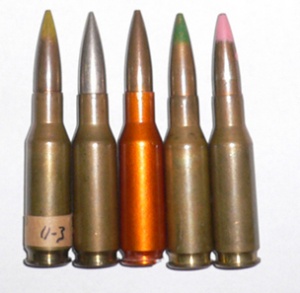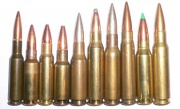.280 British
| .280 British | ||||||||||
|---|---|---|---|---|---|---|---|---|---|---|

| ||||||||||
| Various .280 Ball Cartridges. Orange cased cartridge is made out of aluminium. | ||||||||||
| Type | Rifle | |||||||||
| Country of Origin | United Kingdom | |||||||||
| Specifications | ||||||||||
| Bullet Ø | .284 in (7.2 mm) | |||||||||
| Neck Ø | .313 in (8.0 mm) | |||||||||
| Shoulder Ø | .448 in (11.4 mm) | |||||||||
| Base Ø | .470 in (11.9 mm) | |||||||||
| Rim Ø | .473 in (12.0 mm) | |||||||||
| Rim Thickness | .049 in (1.2 mm) | |||||||||
| Case Length | 1.71 in (43 mm) | |||||||||
| Full Length | 2.54 in (65 mm) | |||||||||
| Production & Service | ||||||||||
| Designer | British Army | |||||||||
| Design Date | 1945 | |||||||||
| Used By | British | |||||||||
| Ballistic Performance Sampling | ||||||||||
| ||||||||||
Contents[hide] |
[edit] History
After the Second World War, the British, having encountered the new 7.92 "Kurz" assault rifle cartridge on the battlefield, began a program to replace the venerable .303 cartridge, which had been marked for replacement for sometime but survived as a consequence of the pressures of wartime on British small arms development. The goal of the British designers was to create a cartridge that would replace all small arms in .303 including the Bren, the No.4 Rifle and the Vickers medium machine gun with a cartridge suitable for a "light rifle". Thus the cartridge had to demonstrate ballistic performance equal to that of a full powered rifle round and yet exhibit as little recoil and blast as possible. After extensive tests by the "Ideal Cartridge Panel" in 1945, the British decided upon two 7 mm cartridges – the .270 and the .276. Both designations reflected the measurement of the distance between the rifling lands in the cartridges' respective barrels; the .276 bullet's actual diameter was .284 inches. In order to focus their efforts, the British ceased research on the .270 and concentrated their efforts on the .276. The .276 was later renamed the .280 even though no dimensions were changed. Recoil of the .280 cartridge was calculated to be a little under half of the .303. Long range performance actually surpassed that of the .303, and shooters reported that it was much more comfortable to fire with the reduced recoil and reduced blast. It seemed that the British designers had accomplished their goals, and proceeded to introduce the cartridge to their NATO allies.
Despite interest from the Belgians (FN would later produced the .280 in quantity and help improve it) and the Canadians, the Americans were not at all interested, claiming they would not adopt a caliber under .30 inch. The British attempted to appease the American biases, first with small changes such as changing the rim diameter of the .280 to the size of the .30-06 (resulting in the .280/30 cartridge which was produced in large numbers). Later, when the .280/30 was outright rejected by the Americans as being too weak with too great a drop in trajectory, the British and Belgians made large changes to the cartridge design. These resulted in several different variations, one was just a .280/30 with the bullet seated less deeply so more powder would be put in the case, another was a T65 cartridge case (the T65 would later become the 7.62x51 NATO) necked down to 7 mm. In the end the different cartridges the British and the Belgians came up with fired 140-grain (9.1 g) bullets at around 2,700 to 2,800 feet per second (850 m/s), but with a much greater blast and recoil than the .280/30, which defeated the design parameters of the initial .280 venture. Unsatisfied with the US Army dragging its feet on the issue, the British adopted the EM-2 and the .280/30 as their primary rifle and ammunition in 1951 with the .280/30 being re-designated as the "7 mm MK1Z". However, this effort was all in vain as the Americans unilaterally adopted the T65, later to be designated the 7.62x51 NATO.
The 7 mm, EM-2 and Taden gun projects were abandoned soon after by Winston Churchill, who desired to have commonality between the NATO countries. Small amounts of .280 would later be produced in the 1960s for various small arms trials.
The .280 British design would later prove to have been far ahead of it time, as the American military later recognized that the 7.62x51 NATO cartridge was too powerful for use in assault rifles, and was forced to make the change to 5.56x45mm NATO, which demonstrated the emergence and dominance of intermediate cartridges on the battlefield. Ironically, in 2002 the Americans developed a new military calibre called the 6.8 mm Remington SPC which is ballistically very similar to the .280 British cartridge. Over 60 years after the .280 British cartridge was designed, the clock has now turned full circle.
[edit] Specifications
| Name | Bullet Diameter | Case Length | Rim | Base | Shoulder | Neck | OAL | MV | Bullet Weight |
|---|---|---|---|---|---|---|---|---|---|
| .280 British | 7.214 mm (.284 inch) | 43.434 mm (1.71 inch) | 12.01 mm (.473 inch) for the .280/30 or 11.633 mm (.458 inch) for the .280 | - | - | - | 64.516 mm (2.54 inch) | Approx. 2,500 ft/s (760 m/s) with 140-grain (9.1 g) bullet | 130–140 grains |
Types of bullets and colours of tips:
- AP (130 grains)
- API (130 grains): black
- Ball (130–140 grains): plain (unmarked), green, pink, yellow, brown
- Observation (130 grains) (6 grains WP): red
- Tracer (130 grains): white
Note: Most cartridges have been observed with a purple annulus. Several experimental cartridge cases were made out aluminium and are of various colors including orange.
Known manufacturers:
[edit] Performance
The following comparisons are excerpts from a manual published by the "Small Arms Group Armament Design Establishment" from the Ministry of Supply[2]:
| .280 | .303 | .30/06 | |
|---|---|---|---|
| Bullet weight in grains | 139 | 174 | 166 |
| Muzzle velocity in ft/s | 2,500 | 2,456 | 2,770 |
| Timber penetration at 2,000 yards | 2.9 in | 2.4 in | 1.6 in |
| Timber penetration at 100 yards | 45 in | 42 in | 47 in |
| Range for penetration of airborne type steel helmet | 1,000 yards | 900 yards (800 m) | 1,600 yards |
| Vertex height in feet for 600-yard (500 m) range | 3.3 | 3.1 | 3.0 |
| Recoil energy per round (smaller is less recoil) | 7.4 ft·lbf with EM-2 | 11.0 ft·lbf with No.4 Rifle | 14.4 ft·lbf with the Garand |
[edit] Variants
- .270: Designed at the same time as the .280. It has a slightly smaller bullet diameter of .279 inches (versus .284 for the .280) but a lighter bullet (93 to 100 grains (6.5 g)) with a greater muzzle velocity (2750–2800 ft/s), longer case (1.8 inches) and shorter OAL (2.45 inches). Research was abandoned in 1948.
- 7 mm "Optimum": The original .280 round with the bullet seated less deeply, giving an OAL of 2.6 inches (66 mm).
- 7 mm "High Velocity": Longer case (1.95 inches), with an OAL of 2.79 inches (71 mm). Similar 140-grain (9.1 g) bullet fired at 2,750 ft/s (838 m/s).
- 7 mm "Compromise" (aka T65/7 mm): Necked down T65 (7.62x51 NATO) to 7 mm. Case length 2 inches (51 mm), OAL 2.8 inches (71 mm), similar 140-grain (9.1 g) bullet fired at 2,800 ft/s (850 m/s).
- 7 mm "Second Optimum" (7x49 mm) : Designed by FN. Also known as the 7 mm "Medium" and the 7 mm "Liviano". FN would later sell FAL rifles chambered in this caliber along with a sizeable amount of ammuition to Venezuela. Longer case (1.935 inches) with an OAL of 2.78 inches (71 mm). 140-grain (9.1 g) bullet fired at 2,755 ft/s (839.7 m/s).
- 6.25 mm (6.25x43 mm): A British experimental cartridge designed during the early 1970s, using the .280/30 as a parent case, which was necked down to fit a smaller bullet.
[edit] Comparable cartridges
For .280:
- 7 mm Bench Rest (Wildcat cartridge, at one time produced by Remington Arms)
- .308 x 1.5" "Barnes" (Wildcat)
- .308 x 1.75" and necked down 7 mm variant (Wildcats)
For 7 mm HV, 7 mm Compromise, 7 mm Second Optimum:
[edit] See also
- EM-2 assault rifle
- Taden gun
- 7 mm caliber, other 7 mm cartridges
- 7.92 x 33 mm
- 7.62x51mm NATO
- .276 Pedersen
- 6.8 SPC
- 6.5 Grendel
- 5.56 × 45 mm NATO
[edit] References
- ↑ Cartridges of the World 11th Edition, Book by Frank C. Barnes, Edited by Stan Skinner, Gun Digest Books, 2006, ISBN 0-89689-297-2 p. 349
- ↑ Reprinted by Dugelby, Thomas B.. EM-2 Concept & Design; a rifle ahead of its time, Collector Grade Publications, 1980, p. 247
- Dugelby, Thomas B. (1980). EM2: Concept and Design. Toronto: Collector Grade Publications.
- Labbett, P; P.J.F Mead. Technical Ammunition Guide: British 7 mm Ammunition.
- Stevens, R. Blake (1993). The FAL rifle. Toronto: Collector Grade Publications. ISBN 0-88935-168-6.
- Popenker, Maxim; Anthony G. Willams (2005). Assault Rifle. Ramsbury: Crownwood Press Ltd. ISBN 1-86126-700-2.
